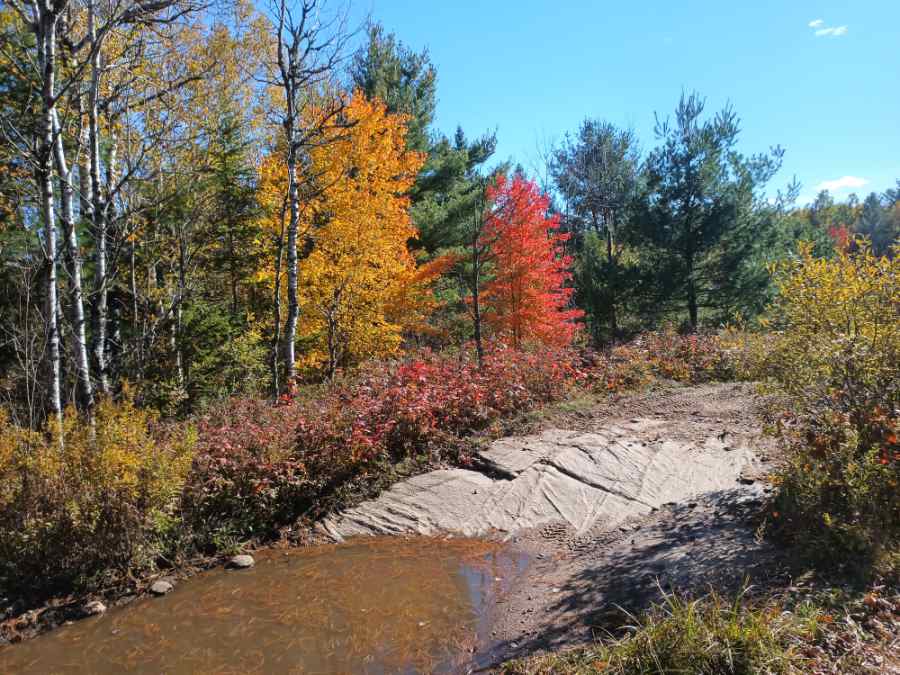Why Succession is Key to Naturalistic Landscape Design in Haliburton County
“Arrested succession” is the secret to creating beautiful and biodiverse landscapes. It’s one of the most important things in my toolkit.
Table of contents
What is succession?
As you might have learned at school, succession is an ecological process: the development of a plant and animal community over time. After land is disturbed, a community of plants and animals quickly colonizes, but that community is over the months and years replaced by a succession of communities, featuring different plants and animals.
Succession in Haliburton County
What does that mean in Haliburton County? In our upland areas (to put it simply), it means forest. Clear a patch of land and wait. If you wait long enough, you get forest back. (At our house, we had to clear part of the forest for solar panels. A year later, the area was full of pioneer herbs and shrubs; seven years later there are many pioneer tree species.)
Off Milburn Road, in the south of the county, you’ll find my favourite Highlands landscape. Here is the site of the county’s last major forest fire. Although the fire happened decades ago, the succession process has been slow because the soil is particularly thin, making it hard for later-succession species to take hold.
The result is what I consider a particularly beautiful landscape, where perennials and shrubs still dominate, but early succession trees are beginning to establish.







Early succession and biodiversity
These habitats are particularly rich in biodiversity. The increased availability of sunlight allows herbaceous perennials to grow, which in turn provide nutrition and habitat for pollinators. The presence of a rich shrub layer provides nesting habitat and food for birds. And that same dense woody plant material provides cover and food for mammals.
This type of habitat is rare in Haliburton County. Indeed, if left undisturbed, over time it disappears and becomes forest, supporting a different range of wildlife.
Early succession and aesthetics
It’s hard to deny the beauty of these landscapes. Just look again at the pictures above. I don’t know if it’s the patchwork and variety of species that makes it attractive, or whether these ecosystems allow light, colour and shadow to intermingle in a way that is pleasing. Or perhaps, deeper down, we realize these habitats are excellent sources of food. Maybe they remind us of our heritage thousands of years ago on the savanna.
I can’t help but think that there is a close connection between biodiversity and visual aesthetics. So why not build on that with the landscapes we create around our homes and cottages?
Arrested succession in landscape design
Every time we do something in our gardens and landscapes, we cause disturbance – we’re affecting succession. Disturbance isn’t necessarily a bad thing. While fire can be considered a major disturbance, it does serve to create increased biodiversity once succession begins to take hold.
While many of the projects I do here at Grounded are akin to traditional horticulture (but using native plants), some are deliberately working with succession in landscape design.
I’ve written before about a “woodland glade” project I undertook in 2024. The idea behind this project was to hold succession at peak biodiversity and visual appeal. I added herbaceous perennials and a few shrubs while at the same time advised the homeowner to continue to remove tree seedlings and saplings.

Another project I am currently working on ready for installation in spring 2025 is a large shoreline area bordering the forest. I’m adding perennials and shrubs to the shoreline while the homeowner continues to remove tree seedlings. Close to the forest I am creating an early successional environment by adding a layer of shrubs. Not only does this add more habitat and hence wildlife to the site, but it also adds visual appeal: these shrubs will flower in spring, bear berries in summer and colourful leaves in fall.
Surely this is a win-win. We have landscapes that are not only beautiful to us but are also rich in biodiversity.
Perhaps this is the niche humans should play within ecosystems. Instead of using our minds to destroy, maybe we can use our intelligence to create a richer, more beautiful world?
I hope so.
Simon Payn
November 6, 2024
Further reading and sources:
https://www.britannica.com/science/ecological-succession
https://dwr.virginia.gov/blog/what-is-early-successional-habitat/
https://cmi.vt.edu/content/dam/cmi_vt_edu/docs/Early%20successional%20habitats.pdf
https://northernwoodlands.org/articles/article/complex-early-successional-forest
